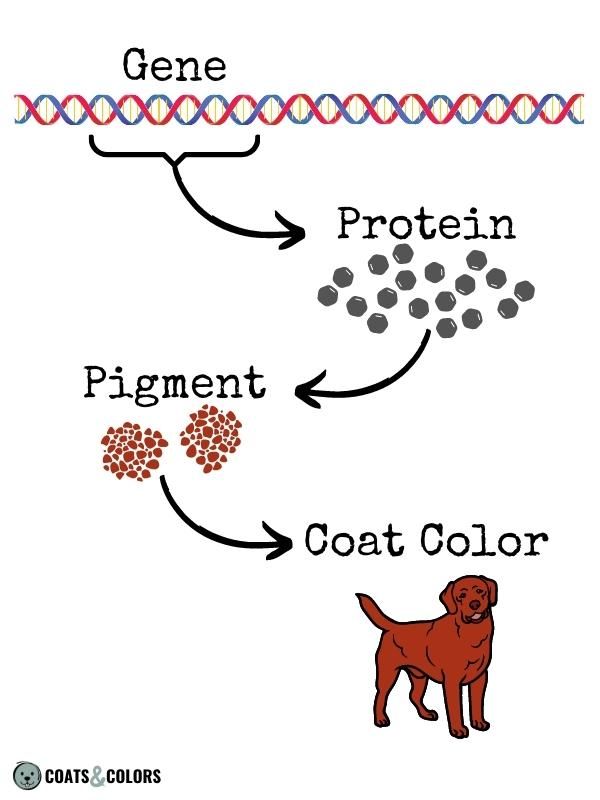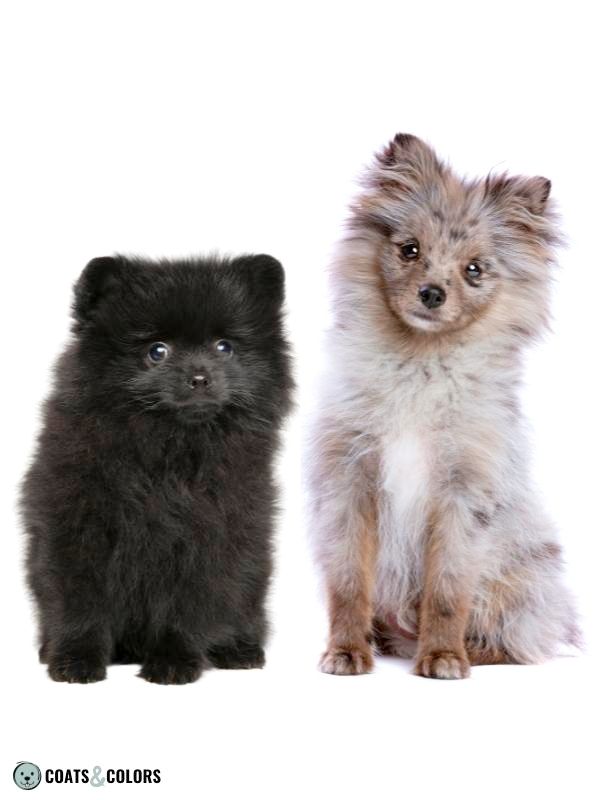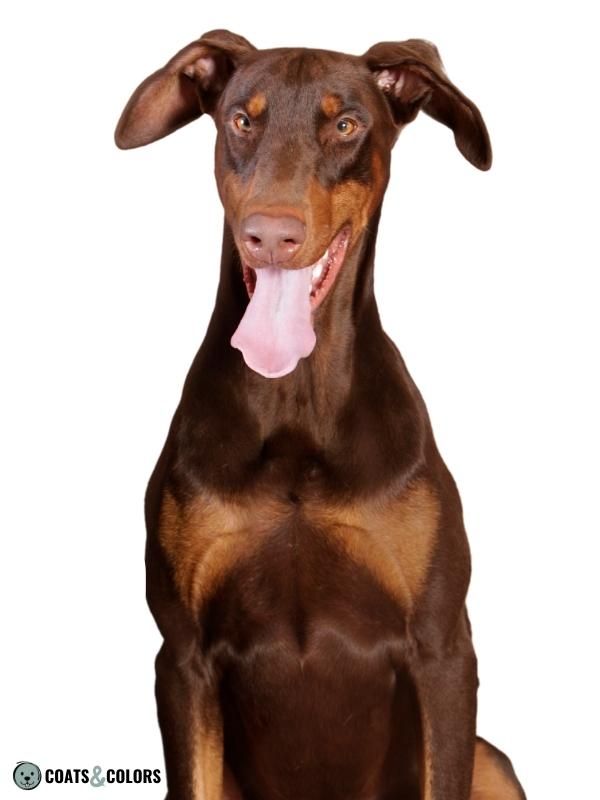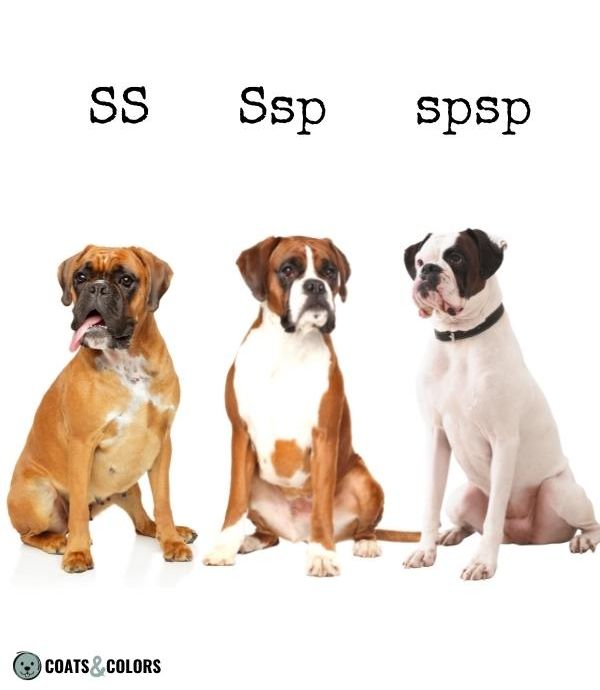All the different aspects of a dog’s coat like texture, length, color or pattern are controlled by a handful of genes, their variations and their mode of inheritance.
If you want to learn more about dog coat color genetics now is the time to freshen up some of the basics before we dive deeper into the inheritance of coat colors in dogs.
Content
Genes & Alleles
Think of DNA as the instructional manual of your dog.
A single gene is a small unit of DNA that contains the information a cell needs to build a specific protein. The entirety of building plans in a dog’s DNA is called its genome.

But quite obviously not all dogs are built the same. And that’s because different dogs can have slightly different versions of the same gene. These gene variants are called alleles.
Alleles are the result of mutations in a gene.
Not all mutations in a gene cause a visible change in phenotypic expression. However, if we look at coat color genes we are only interested in mutations that actually do change how our dogs look.
Example: Every dog has a Merle gene in its DNA. However, not every dog has one of the alleles (M*/m) that can actually cause a Merle phenotype. Most dogs only have the original non-merle alleles (m/m).

Genes come in pairs, one copy is inherited from the dog’s father and one from its mother.
So if we look at a specific gene we find a set of two alleles, one inherited from each parent.
Different genes and their alleles get assigned a unique letter to simplify things a little.
Every newly found allele that behaves in a new way gets assigned its “gene letter” and then maybe some superscripted descriptive letter or symbol.
Example: At the K-Locus we find alleles like KBlack, kbrindle and kyellow that we simply call KB, kbr and ky.
The list of all the possible alleles on a specific locus is called its allelic series.
The original gene variant as it typically occurs in nature is dubbed the wild type. Alleles of a gene are derived from the wild type through genetic mutation.
Here you find a summary of all the color genes in dogs.
Sooner or later you’ll want to learn all these letters and terms to understand the big picture of coat color genetics. But don’t worry, we’ll walk you through it.
Gene Locus
The DNA in every cell is split into different DNA molecules called chromosomes. Humans have 46 chromosomes, dogs have 78 chromosomes. You can read more about canine genetics here.
A gene locus (plural loci) technically means the actual physical location of a specific gene in a dog’s genome (locus is the Latin word for “place”). However, the terms “gene” and “locus” can be used interchangeably when discussing a dog’s coat color.
Example: The ASIP gene contains the plan to build Agouti-signaling protein. But this gene is simply called Agouti Locus or even shorter A-Locus. Each dog can only have 2 of the 6 possible versions of the A locus (Ay, Ays, aw, asa, at, or a), one from his mom and one from his dad (e.g. Ay/at or aw/aw).
Heterozygosity & Homozygosity
If a dog has two exact same copies of a gene (e.g. B/B or d/d), he is homozygous at a specific locus. If he has two different alleles of a gene (e.g. M/m or E/e) , he is heterozygous at a specific locus.
Example: On the K-Locus we know of 3 possible alleles (KB, kbr and ky) with 6 possible combinations. A dog with KB/KB, kbr/kbr or ky/ky is homozygous at the K-locus. A dog with KB/kbr, KB/ky or kbr/ky is heterozygous at the K-locus.
Different dog breeds act as separate sub-populations within all dogs. Purebred dogs are often limited to only some of all possible coat colors and display a relatively high grade of homozygosity.

Example: We know that all Rottweilers are short-haired and black & tan due to selective breeding for this coat and pattern. So basically all Rottweilers are homozygous for smooth coat (L/L), black eumelanin (B/B) and a tan point pattern (at/at). Alleles for other coat types, colors or patterns only occur at a very low frequency or have disappeared from the Rottweiler gene pool.
Genotype & Phenotype
The genotype is the representation of an organism’s actual collection of genes and alleles. We use a standardized letter code and universally accepted genetic terms to describe coat colors as precisely as possible.
If we talk about a dog’s genotype we list the gene loci and alleles. If you know the different color genes in dogs you can often predict how a dog looks simply by knowing its genotype.
Example: A dog with the genotype of ky/ky E/e at/at b/b is rather likely a brown dog with a sharply defined and symmetrical tan point pattern like a brown-and-tan Dobermann.

The expression of genes of a dog’s genotype leads to its visible phenotype.
If we talk about the phenotype we discuss what we see as best as we can. The breed standards of different dogs list the desired coat colors for a specific breed in a descriptive manner.
The problem is that phenotypical descriptions often use made-up terms and are not very specific. Additionally, different breeds often use their own terms to describe different coat colors.
Be aware of the information gap when discussing a dog’s genotype vs. its phenotype.
Example: If someone simply tells you their dog is “brown” or “red“, it could be liver-colored with or without tan markings or maybe sable with or without dark shading or even recessive red.

Modes Of Inheritance
If a dog is heterozygous at a certain gene locus he has two different alleles. There are different patterns of inheritance that influence which of these different alleles is expressed in a dog’s phenotype.
Dominant And Recessive Genes
Many of the color alleles we discuss on this site follow a path of complete dominance: If one dominant allele is present it will completely mask the presence of a recessive allele.
Dominant alleles do not always suppress the expression of the recessive allele, more often they simply overrule the effects the recessive allele would have caused.
Example: On the B-Locus there are only two possible alleles (B and b) so a dog could be either B/B, B/b or b/b. B represents the wild type allele and holds the information a dog needs to build black pigment. The mutated version b lost this information and causes brown pigment if there is no B present.
Since one intact B allele is enough for a dog to build black pigment B acts dominant over b. A dog with B/B or B/b provides all the information of a B building manual for black pigment. Only a dog with two recessive alleles b/b lacks all the necessary information to build black pigment and can only produce brown pigment.

Since the presence of the recessive allele is hidden in the phenotype we call heterozygous dogs a carrier of the recessive trait. A B/b dog itself is black but carries brown.
Recessive traits can skip generations and will only be expressedd if they are inherited from both parents.
Incomplete Dominance
In some cases, a heterozygous condition on a specific gene locus can lead to a blend of both traits or an intermediate effect in the phenotype. We call this incomplete dominance or partial dominance.
Here, none of the alleles can fully mask the effect of the other allele.
Instead, the interaction between two different alleles leads to a dosage-dependent effect and causes visibly less intense expression of a certain trait in dogs with just one copy.
Example:
There are two possible alleles (S and sP) in the S-Locus series. A dog can be either S/S, S/sP, or sP/sP.
S represents the wild type allele and leads to a fully pigmented solid coat.
The mutated version sP causes white spotting.
Homozygous dogs (sP/sP) have on average more white spotting than heterozygous dogs (S/sP).

Another example of a color gene that acts as an incomplete dominant trait is Merle.
The impact of Merle alleles is dose-dependent with two copies having a stronger effect than one copy (and longer alleles in these combinations causing more effect than shorter alleles).
This mode of inheritance usually allows for a wide range of possible outcomes. The impact of a single dose can vary and make it difficult to reverse-engineer a dog’s genotype just from his looks.
Co-Dominance
If both alleles of a heterozygous genotype are equally visible and don’t mix to create an intermediate phenotype we speak of true co-dominance. Both alleles get expressed independently in the phenotype.
One example of this is the AB blood type where both A and B proteins are expressed at the same time.
Some color traits that might show some co-dominance are the A locus patterns or possibly Ticking.
Epistasis
Not only single alleles on a certain locus can interact with each other. Some genes can mask or interfere with the expression of other genes at other loci.
Epistatic interactions can also work on a scale from mild interaction to fully repressing the effect of another gene on the phenotype level.
Example:
Every dog has some pattern at his A-locus.
However, this pattern will not be expressed if he also has a KB allele at the K-locus. The K-locus acts epistatic to the A-locus as part of the pigment type switch system.
The effect of both the A and K genes can be restricted by the E locus.
Modifier Genes
If a gene affects the phenotypic expression of another gene we call it a modifier gene. This could be interpreted as a form of epistatic interaction (one gene affecting the expression of another gene).
Modifier genes require another gene whose effect they can modify.
Example: Harlequin in Great Danes acts as a merle modifier.
Being able to breed for certain traits within a pattern makes it obvious that there is a yet unknown genetic component to them. This covers things such as the amount of dark overlay in a shaded sable pattern or the amount of white in a piebald pattern.
Further Reading
If you want to learn more, there are plenty of great resources available for free!
- Genetic Science Learning Center: Basic Genetics.
- The Useful Genetics Project: Course Material.
- Khan Academy: Mendelian genetics.
Learn More

Hi! I’m Steffi. I am a biologist and a big time dog nerd. You are curious about coat color genetics? You’ve come to the right place! Read more.







